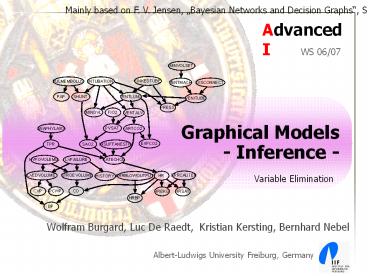Graphical Models - Inference - - PowerPoint PPT Presentation
1 / 29
Title: Graphical Models - Inference -
1
Graphical Models- Inference -
Mainly based on F. V. Jensen, Bayesian Networks
and Decision Graphs, Springer-Verlag New York,
2001.
Advanced I WS 06/07
Variable Elimination
- Wolfram Burgard, Luc De Raedt, Kristian
Kersting, Bernhard Nebel
Albert-Ludwigs University Freiburg, Germany
2
Outline
- Introduction
- Reminder Probability theory
- Basics of Bayesian Networks
- Modeling Bayesian networks
- Inference
- Excourse Markov Networks
- Learning Bayesian networks
- Relational Models
3
Elimination in Chains
- Forward pass
- Using definition of probability, we have
- Inference (Variable Elimination)
4
Elimination in Chains
- By chain decomposition, we get
- Inference (Variable Elimination)
5
Elimination in Chains
- Rearranging terms ...
- Inference (Variable Elimination)
6
Elimination in Chains
- Now we can perform innermost summation
- Inference (Variable Elimination)
7
Elimination in Chains
X
- Rearranging and then summing again, we get
- Inference (Variable Elimination)
8
Elimination in Chains with Evidence
- Similar due to Bayes Rule
- We write the query in explicit form
- Inference (Variable Elimination)
9
Variable Elimination
- Write query in the form
- Iteratively
- Move all irrelevant terms outside of innermost
sum - Perform innermost sum, getting a new term
- Insert the new term into the product
Semantic Bayesian Network
Eliminate irrelevant variables
- Inference (Variable Elimination)
10
Asia - A More Complex Example
- Inference (Variable Elimination)
11
We want to compute P(d)Need to eliminate
v,s,x,t,l,a,b
- Initial factors
- Inference (Variable Elimination)
12
We want to compute P(d)Need to eliminate
v,s,x,t,l,a,b
- Initial factors
Eliminate v
- Inference (Variable Elimination)
13
We want to compute P(d)Need to eliminate
s,x,t,l,a,b
- Initial factors
Eliminate s
- Inference (Variable Elimination)
Summing on s results in a factor with two
arguments fs(b,l). In general, result of
elimination may be a function of several variables
14
We want to compute P(d)Need to eliminate
x,t,l,a,b
- Initial factors
- Inference (Variable Elimination)
Eliminate x
Note that fx(a)1 for all values of a
15
We want to compute P(d)Need to eliminate t,l,a,b
- Initial factors
- Inference (Variable Elimination)
Eliminate t
16
We want to compute P(d)Need to eliminate l,a,b
- Initial factors
- Inference (Variable Elimination)
Eliminate l
17
We want to compute P(d)Need to eliminate a,b
- Initial factors
- Inference (Variable Elimination)
Eliminate a,b
18
Variable Elimination (VE)
- We now understand VE as a sequence of rewriting
operations - Actual computation is done in elimination step
- Exactly the same procedure applies to Markov
networks - Computation depends on order of elimination
- Inference (Variable Elimination)
19
Dealing with Evidence
- How do we deal with evidence?
- Suppose get evidence V t, S f, D t
- We want to compute P(L, V t, S f, D t)
- Inference (Variable Elimination)
20
Dealing with Evidence
- We start by writing the factors
- Inference (Variable Elimination)
21
Dealing with Evidence
- We start by writing the factors
- Since we know that V t, we dont need to
eliminate V - Instead, we can replace the factors P(V) and
P(TV) with
- Inference (Variable Elimination)
22
Dealing with Evidence
- We start by writing the factors
- Since we know that V t, we dont need to
eliminate V - Instead, we can replace the factors P(V) and
P(TV) with - This selects the appropriate parts of the
original factors given the evidence - Note that fP(v) is a constant, and thus does not
appear in elimination of other variables
- Inference (Variable Elimination)
23
Dealing with Evidence
Given evidence V t, S f, D t, compute P(L,
V t, S f, D t )
- Initial factors, after setting evidence
- Inference (Variable Elimination)
24
Dealing with Evidence
Given evidence V t, S f, D t, compute P(L,
V t, S f, D t )
- Initial factors, after setting evidence
- Eliminating x, we get
- Inference (Variable Elimination)
25
Dealing with Evidence
Given evidence V t, S f, D t, compute P(L,
V t, S f, D t )
- Initial factors, after setting evidence
- Eliminating x, we get
- Eliminating t, we get
- Inference (Variable Elimination)
26
Dealing with Evidence
Given evidence V t, S f, D t, compute P(L,
V t, S f, D t )
- Initial factors, after setting evidence
- Eliminating x, we get
- Eliminating t, we get
- Eliminating a, we get
- Inference (Variable Elimination)
27
Dealing with Evidence
Given evidence V t, S f, D t, compute P(L,
V t, S f, D t )
- Initial factors, after setting evidence
- Eliminating x, t, a, we get
- Finally, when eliminating b, we get
- Inference (Variable Elimination)
28
Dealing with Evidence
Given evidence V t, S f, D t, compute P(L,
V t, S f, D t )
- Initial factors, after setting evidence
- Eliminating x, t, a, we get
- Finally, when eliminating b, we get
- Inference (Variable Elimination)
29
Outline
- Introduction
- Reminder Probability theory
- Basics of Bayesian Networks
- Modeling Bayesian networks
- Inference (VE, Junction Tree)
- Excourse Markov Networks
- Learning Bayesian networks
- Relational Models































